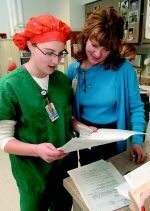by
Michael Johns, Project Manager | April 26, 2006

Radiology nurses
support ALL modalities
Nurses pondering career options often overlook one specialty lauded loudly by its practitioners - radiology nursing
"I don't think nurses think about it, not at all - I certainly didn't know anything about it," said Jill Earp, BSN, a radiology nurse at The University of Kansas Hospital for the past 2 1/2 years.
She's talking about radiology nursing, a specialty she found after about six years as a critical care nurse. Earp's experience as an agency nurse brought her in contact with the radiology department at KU, and she became curious.



Ad Statistics
Times Displayed: 1581
Times Visited: 8 Keep biomedical devices ready to go, so care teams can be ready to care for patients. GE HealthCare’s ReadySee™ helps overcome frustrations due to lack of network and device visibility, manual troubleshooting, and downtime.
"I had sent people to radiology to have lines placed, but I had no idea about all the types of procedures they do."
Kristin Schwartz, RN, BSN, had a radiology technologist friend suggest she explore radiology nursing. Like Earp, she's now been a radiology nurse for 2 1/2 years, and, like Earp, she was surprised to discover this specialty.
"It's a pretty interesting job, and I had no idea about it...We do tons of different things in radiology," Schwartz said.
Without a doubt, the variety radiology offers appeals, said Julie Suppenbach, RN, CRN, the nurse manager in KU's radiology department. Suppenbach manages a group of 12 nurses who provide support "to all the different modalities." That means everything from MRI breast biopsies to brain scans and the new cardiac CT scans.
"We work hand-in-hand with the physicians and technologists...We work with cardiology, with nephrology, neurology, pediatrics - many specialties and in many different ICUs...There are different procedures involving all different parts of the body, from the head to the foot," Suppenbach said.
Radiology nurses, according to the American Radiological Nurses Association (an organization in existence only since 1981): "provide, promote and maintain continuity of quality patient care in imaging environments such as general diagnostic, neuro/cardiovascular/interventional, ultrasonography, computerized tomography, nuclear medicine, magnetic resonance and radiation oncology."
The focus in all is the patient, whether the case is critical or not. "We may be giving oral sedation to someone about to have an MRI to make them less anxious - or we may be working with ICU patients," Suppenbach said. "You have a lot of hands-on time with the patient," Earp said. "We are very busy, doing many things for our patients."
Along with the care challenges and rewards are the challenges and rewards of working with constantly evolving tools and procedures. The science and technology of radiology also have appeal.
"It is so different from other areas of nursing," Earp said. "It gives you an opportunity to constantly learn...Today, I worked with a patient in the Cath Lab with the new CT scanner. This is a procedure that will replace a six- to eight-hour procedure with a 10-minute procedure - it is just revolutionary!"

